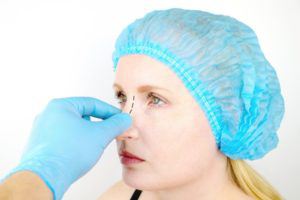Deviated Septum Repair (Septoplasty)

You might have been born with your deviated septum, or your nose might have been injured in a number of ways. It’s likely no one notices you have a deviated septum, but you notice; and, you might be suffering because of it. Maybe you have frequent sinusitis, unpleasant nasal discharge, or you snore so loud your partner doesn’t want to sleep in the same bed as you. Fortunately, not all hope is lost. You can have your deviated septum repaired so you can breathe more easily and eliminate unpleasant side effects.
You might be concerned about having a surgical procedure, but deviated septum repair is commonplace and in most cases, the benefits of fixing your nose far outweigh the risks. Below we provide more information about exactly what a deviated septum is and how you can tell if you have one, followed by an in-depth explanation of treatment for a deviated septum.
What Are the Signs of a Deviated Septum?

Your nasal septum, which is constructed of cartilage and bone, is the thin wall that separates your nasal passages. A deviated septum refers to a nasal septum that is crooked or off-center, making one nasal passage smaller than the other. Many people don’t have symmetrical nasal passages, but those with a severely deviated septum can suffer uncomfortable, inconvenient, and sometimes painful side effects. Other times people might experience symptoms of a deviated septum and not even realize they have one. Some signs and symptoms of a deviated septum you can watch for include:
- Difficulty breathing through the nose. This indicates that you likely have an obstruction through one or both of your nostrils. It’s typically more noticeable when you have allergies or cold which causes your nasal passages to narrow because of swelling.
- Frequent nosebleeds. A deviated septum can cause your nasal passages to be drier than usual, resulting in frequent nosebleeds.
- Snoring. Breathing while sleeping is also difficult with a deviated septum, which leads to loud breathing and snoring while sleeping.
- Dry mouth. Some who have a deviated septum naturally compensate for difficulty breathing through their nose by breathing through their mouths. This leads to a dry mouth.
- Poor sleep. When those who have a deviated septum struggle with breathing, they often don’t get the best quality of sleep, or they wake up frequently throughout the night. In severe cases, some might even develop sleep apnea, which can be life-threatening.
- Nasal or Sinus congestion. A deviated septum can block one or both of your nostrils. Although this impacts a person’s breathing ability, it also creates feelings of pressure in the sinuses.
- Headaches. With built-up pressure in the sinuses because of an obstruction and trouble breathing, it’s not uncommon for those with a deviated septum to suffer from regular sinus headaches.
- Recurring sinus infections. When those with a deviated septum have clogged nasal passages, they are more prone to regular sinus infections, or sinusitis. The infection might not go away, or it keeps recurring. Sinus infections can also cause inconvenient and uncomfortable nasal discharge.
Deviated Septum Repair Treatment

- Septoplasty is the surgical procedure done on a deviated septum to correct the deviation and make your septum straight, so your nasal passages are even and allow air to flow through for better breathing. A septoplasty can be done in the office if small and limited under local anesthesia, or as an outpatient procedure which takes between 45 minutes and one hour. The surgeon makes a small half-inch incision inside the nose and corrects the septum without breaking nasal bones. A patient who has a septoplasty would not have to wear a cast or suffer from external bruising. In less than a week, patients are recovered and back to normal activities. This procedure is often covered by most insurances for breathing problems as there are no cosmetic changes to the nose.
- Septorhinoplasty is a surgical procedure used to reshape a person’s nose as well as correct any cosmetic deformities. Patients might wish to improve the appearance of their nose by having a bump removed, reshaping the tip, or reduce the size of the nose. When rhinoplasty is included in deviated septum repair, it’s still a short outpatient procedure (usually about 2 hours). The surgeon makes small incisions within the nostrils and might make cuts across the base of the nose in more difficult cases. The surgeon then reshapes the cartilage and inner bone which make up the nose to the desired shape. If you have a rhinoplasty, you will have to wear a nasal splint for at least a week and you likely experience some swelling and bruising around the nose and eyes. This can last for up to two weeks but will begin to improve a few days after surgery. Cosmetic changes to the nose are never covered by insurance companies and will be an additional out-of-pocket cost to the patient, however if done at the same time as breathing concerns are addressed, the costs can be limited.
When you suffer from a deviated septum this means the thin wall of bone and cartilage separating your nasal passages is uneven, and likely causing you a wide variety of annoying, inconvenient, and perhaps painful, symptoms. You don’t have to live with this discomfort. Instead, you can opt to have your deviated septum repaired. Depending on your symptoms and the extent to which your nasal passages are uneven, you might choose to undergo a septoplasty alone, or in conjunction with a rhinoplasty to reshape your nose and give you your desired appearance.






Whether you’ve considered deviated septum repair, reach out to Southern California Sinus Institute to schedule a consultation today. Award-winning surgeon, Dr. Alen N. Cohen has been helping patients with nasal and sinus disorders for more than a decade and has completed over 10,000 nose and sinus procedures at this time!
